 |
 |
 |
 |
 |
 |
 |
 |
| At a glance, the Festool ATF55e looks like just about any other circular saw but looks can be deceiving. In using the ATF55 I'm continually reminded that although is bears some resemblance to a circular saw it really isn't - at least to me. To me it performs more like a hand held tablesaw than anything else. The ATF55e is part of a package which includes a storage box Festool calls a "Systainer" and a 55" long guide. | 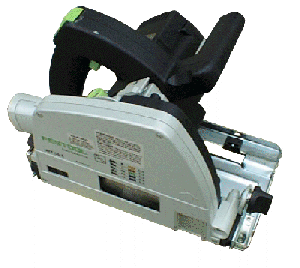 |
| Impressions Again, it looks like a circular saw, but that really doesn't do justice to the way it performs. The first obvious difference between the ATF55 and other circular saws is that it does not have the pivoting circular guard system. This is because the saw is designed to be able to plunge down into the stock much like a plunge router would. The second obvious difference is that the saw is equipped with a riving knife to keep the kerf from closing behind the blade. With the riving knife fitted of course you would not be able to make a plunge cut from the middle of the stock, it is easily removed however. In Use Some of us have been using regular circular saws (also known as an "electric hatchet") in the shop and on the job site for a while. These are really intended to be rough carpentry tools, not cabinet making tools. As a result while these tools do work, they are typically only used for rough cuts and often require secondary operations to complete the finished edge. The ATF55 is designed with FINISHED cabinetmaking operations from the start; this means NO rough cuts - NO secondary operations. The ATF55 comes equipped with what is for all intents and purposes a small diameter cabinet saw blade, the kerf is about 1/8" wide. There are several reasons why this tool performs so well, the first is the blade, the second is the variable speed. The blade speed can be varied from 2000rpm to 4800rpm to match the material being cut. |
|
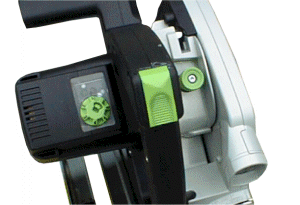 |
On lower speed settings the saw is noticeably quieter than a
typical circular saw, on the highest speed setting it seemed to be about the same as
my Porter Cable saw. I've found that I'm using speed 3 & 4 most often which is pretty
quite for a saw. The saw is also equipped with soft start. Note, speed 6 is
recommended for wood. I've compared the cut quality the Festool saw gives against a newly sharpened Forrest WWII blade used in my tablesaw. The cut from the WWII is better but you can't tell without very close inspection. When used with the guide, I rate the cut quality of the ATF55 comparable to your average tablesaw blade and suitable for panel glue-ups without further operations; pretty impressive for a hand-held saw. |
| Guide Rail One big reason for the high performance of the ATF55 is no doubt directly attributable to the Festool guide rail system. The ATF55 (and some other Festool tools) uses the guide rail to align and guide the cut. The base of the saw has adjustments to snug up the fit between it and the guide rail; this keeps the cut laser-straight. This views shows some laminate flooring material after a rip cut, tear-out would show up as white chips - there are none. |
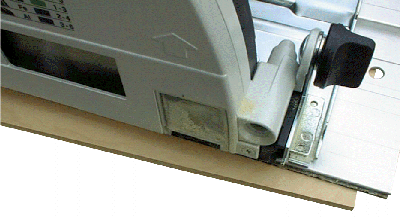 |
| The guide rail itself is as incredibly effective as
it is absurdly simple. It is simply a piece of extruded aluminum with two foam tape strips
underneath and a rubber strip along the cutting edge. This rubber strip presses down at
the exact line of cut (it must be trimmed before its first use). The rubber strip greatly
reduces or totally eliminates tear out. It should be noted as well this works when the saw
is set for a bevel cut as well. The guide rail is simply
lined up with the line of cut desired, the cut is made, and you end up with a cut in
the exact position you want. The foam tape strips on the bottom are remarkably effective
at preventing any shifting during use. Conclusion I think the ATF55e / Guide Rail combination is a remarkable - almost revolutionary tool, if you are in the trades, it will certainly be a worthwhile replacement to whatever it is you are using now. If you are a woodworker and want the same quality cuts on the job-site as you get in the shop this tool will do it. If you are contemplating a panel saw, I'd get a long and short guide rail for the ATF55 and be done with it. I never thought I'd say this but you could even use the ATF55 and guide rails to site-build cabinets if you wanted to. |
|
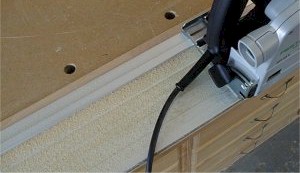 |
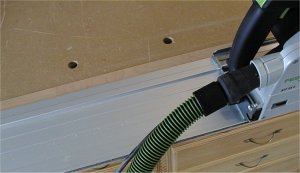 |
| Note: I think saws are notoriously hard to dust collect on. Collection is pretty good on the ATF55 nonetheless. This is an example of the difference between no collection and using collection. Dust is hard to photograph, you might have to trust me that without dust collection, dust was spewed all over. |
|
I would also like to thank my friend Bob Marino for putting me onto the Festool line of tools.
|